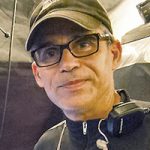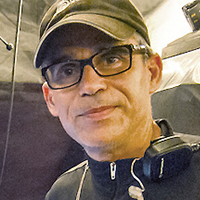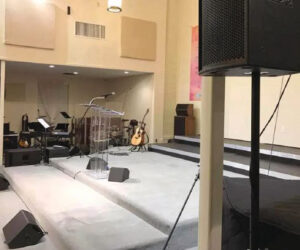If you’re ever discussing an upcoming gig and are told that – “it would normally take this amount of time to do this gig, but we only have the venue for this (smaller) amount of time, so we are going to throw extra labor at it and…” – what you should do, as politely as possible, is get up and run screaming from the room while waving your arms in the air. Maybe take a job in retail until the whole thing blows over.
Every job I’ve ever done that has been set up that way has been a nightmare, and the 1984 Juno Awards was one of those shows. The 1984 iteration of the event (Canada’s equivalent to the Grammys) were, to my knowledge, the first time it was hosted in a different venue than Toronto’s O’Keefe Center, a large “soft seater” theatre. Rather, it was held in The Automotive Building at the Canadian National Exhibition Grounds in Toronto, and it was closer to an arena type show, much like today’s format.
My role, which I didn’t get to choose to accept, was to be the sole representative of the audio company that I worked for at the time. And, oh by the way, try to keep a low profile while doing it as this was an IATSE venue and relations between our company and that union were somewhat…fractious at the time. (I’m proud to say that this situation steadily improved while I was managing the company, but that was some years in the future).
In this case, the “normal” amount of time to mount and broadcast the show was about a week to 10 days, and the “actual” amount of time that the venue was available was three days. As in, 72 hours, and, spoiler alert, I ended up being on site for around 60 of those 72 hours.
Jack Of All Trades
My job description would, today, be “main stage monitors, and patch” but at the time there was just the one stage, a 20 by 30-foot flat deck, and the acts were all live-vocal-to-track, so my job was “everything.”
After my load-in, I handed my tails off to an electrician, connected with my assigned stagehands and began the set-up. This included interfacing with a remote audio truck, which was parked outside the venue. Everything went smoothly, for a while, until we started testing lines to the truck. At that point, we started experiencing buzz and hum issues, which are what ended up keeping me on site for so much time over the duration of the event.
I don’t remember a lot of details about what equipment I had to work with, except that my desk was a Yamaha M916. This was a fully transformer balanced, well grounded member of the PM2000 family, so I was pretty confident my mixer was not the source of the grounding noise. What we had for a splitter going to the truck is lost to history, and I never had a free moment to even walk out to the truck and see what they had going on.

The grounding issues were very random. One thing that I do remember, probably on the second day, was discovering that it took odd combinations of things to get a quiet line. That would be on the order of this: an AKG 451 microphone body, with that capsule and this mic cable into that line on the splitter would be quiet, but other combinations would produce buzz and hum. It makes no sense today, but that’s what appeared to be going on.
So, I stayed late on the first day, went home for a few hours, and came in early on the second day. The stagehands kept changing as their shifts ended, while I stayed on. Every once in a while, I would feel a pair of eyes boring into me and look up and see the union steward, an imposing, bald headed fellow glaring at me, and probably thinking “Who is that guy?” Then, someone would ask him something and he would turn away, probably with the thought “not one of mine…” and that would be that until the next time it came up.
One morning, (I don’t recall which one) I recognized a guy in the new batch of hands coming in as someone who had worked for my company in the past. We had never worked together, but he was part of the legendary first generation of audio folks with the company and was very well regarded.
He knew me well enough to say hello, so we chatted a bit. Eventually I said, “Boy, am I glad you’re here, I could really use someone who knows audio!” Sadly, his response to that was “Me? I’m on props today… I gotta’ go grab a broom!” So much for some professional help.
Adding To The “Fun”
Somewhere along the line it was brought to my attention that I was also responsible for a secondary area – some kind of pre-show event that was happening at the other end of the room, possibly some sort of “red-carpety” thing. I remember exactly two things about that event.
The first was that I had a hard time getting to it after I heard about it. The seating for both the main event and the red-carpet thing was temporary bleacher type seats made from scaffold components. The thing was, even though the two areas were back to back, the seat pitch was different for each, so trying to climb from the top row of one set of seats to the other was really awkward. I was probably too tired to figure out how to get there by walking around the bleachers at that point, although I did figure that out in time for the actual show.
The other recollection is that the desk for that event was a new MC2404 console, which was also the model that we had provided for front of house for the main show. We were a big Yamaha shop at the time, and the owner felt that Yamaha wanted us to showcase their newest product.
Now, I doubt that anyone who used that desk back in the day has ever been nostalgic about that fact. All I remember is using it on the small stage and, thinking of our freelancer who was mixing FOH for the main show, asking myself, “Hmm, maybe we should have provided a PM2000 for FOH?”
Incidentally, the freelancer, who I knew and got on well with but barely saw or interacted with during the whole event, must have made some friends on this one because he ended up retiring as the IATSE head of audio for the venue some 30 years later.
At this point, you might be thinking, “there seems like a pretty modest amount of audio on this show – what were the endless shifts of stagehands actually doing this whole time?” Well, there was a “union affiliated” lighting company in town working on the show (they had some audio gear too… I think they must have provided the mains, probably Meyer Sound UPA-1s for this event, which is why I have no recollection of dealing with a PA). Presumably, they didn’t have enough inventory to cover it, so they had bought hundreds of PAR 64 fixtures to light this enormous barn of a venue.
These days, when you buy a lighting fixture, you basically just have to plug it in and turn it on. But back then, partly because there were so many different “standards” for connections and mounting (e.g., Edison, twist-lock, stage-pin, etc.) that a “new fixture” was just the metal can and the yoke. This meant that hundreds of C-Clamps, safety cables, PAR bulbs and plugs had to be fitted.
In this case, the plugs they chose were U-Ground (Edison) plugs, and the reason they went that route is the cabling was orange extension cords! These came in huge cardboard boxes mounted on pallets and were 50 and 100-foot coils, shrinkwrapped in plastic.
I watched stagehands spend an entire shift just reaching into the box, pulling out a cable and punching their fist through the shrink wrap, and then handing the coil off to the next person in line. These were, in turn, unrolled and bundled into massive anacondas of bundled cable, sometimes a foot thick. I quickly learned not to glance up into the high steel because it was nauseating to see all of that orange up there.
But I digress…
Too Little, Too Late
By the third day – show day – I was pretty much running on fumes. Nonetheless, we had managed to get the system to be quiet and, after an interlude in the CBC wardrobe department where I was “fitted” (“here, try this one, it looks like your size!”) for a black shirt and sport jacket (in case I was on camera at any point), I managed to a) mix the red-carpety thing, whatever it was, and b) get through the show without any flubs or issues.
And so began the load out. This was kind of a free-for-all because the deadline for being out of the building was fast approaching. As is often the case in these situations, the “you can’t touch this… get one of the hands to move that!” thing had pretty much gone out the window by that point.
So, when all I had left to strike was my tails, I looked around, briefly, for an electrician (or someone to even ask to find an electrician) and coming up blank, turned my attention to the electrical tie-in. This was a 100-amp switch box, nestled in the web of an upright I-beam near the stage. My tails, which was a short piece of 6/4 cable with a 60-amp Joy connector on it, was hanging straight out of the box, with no strain relief on the cable.
I checked that the switch was “off” and opened the box. I’ll just pause here to say that, ever since I had learned the correct order to connect the various wires (Ground FIRST, Neutral SECOND, Hots LAST, reverse that order when untying) that I always, always, always followed it, regardless of whether anything was “live” or not.
So, I undid the red hot, then the black one and moved on to the neutral (white) wire. As I undid the screw holding the neutral in place and directed my screwdriver towards the ground terminal, my tails shot to the floor… because, and this is the punch line to this whole sorry tale folks, the ground connection had never been tightened! And that’s why I had spent so much quality time on this show tracking down buzzes and hums instead of doing other things… like sleeping… and eating.















